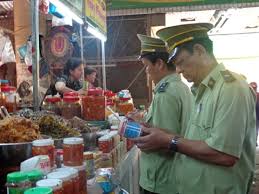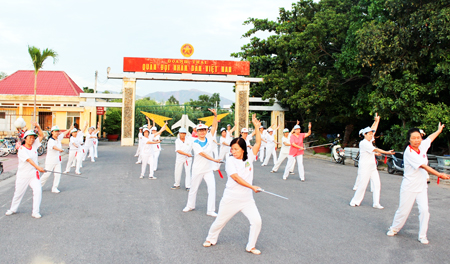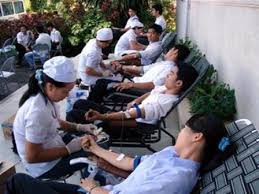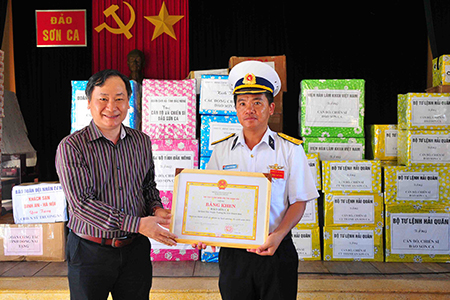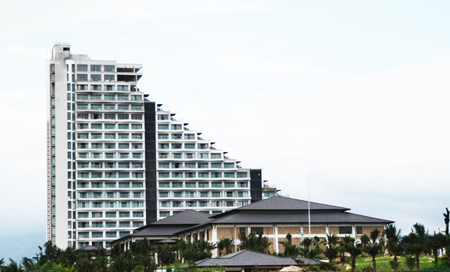
After 10 years of foundation, Cam Lam District has experienced much urban growth with improved traffic infrastructures, concreted roads, spacious schools, well-equipped medical stations, electricity access...
After 10 years of foundation,
Cam Lam District has experienced much urban growth with improved
traffic infrastructures, concreted roads, spacious schools, well-equipped medical stations,
electricity access,
etc.
 |
| Newly-opened Duyen Ha Hotel. |
Smooth traffic flow
Nguyen Lai, Chairman of Cam Lam District Farmers’ Association still remembered difficulties and hardship during the first days of the district foundation. It took him hours to travel for 30km to work because of challenging roads.
“The roads in Bai Dai have been concreted, facilitating travel,” says Hoang Anh Phu, Cu Hin Village, Cam Hai Dong Commune. the district has basically completed the traffic system from the district center to the commune center, prioritized traffic works connected to the national road and the provincial road in order to improve the local road network with such roads as Dinh Tien Hoang, Ly Thai To, Ham Nghi, Pham Van Dong, etc, according to Nguyen Tri Tuan, Vice-Chairman of the District People’s Committee.
Rural traffic system and other essential infrastructures in communes and densely-populated areas have been improved to meet new rural construction criteria. Over the past 10 years, the district has upgraded more than 241 km of roads, bringing concreted roads to more than 308km, accounting for 48.43%. Many roads have been built and upgraded in Cam Duc Town and Suoi Tien. In the period 2011-2015 alone, the district invested VND361 billion in the construction of over 114 km of roads.
Urban connection with communes
Since 2011, the district has invested in urban and rural infrastructures aiming at meeting the 4th-class urban standard in Cam Duc Town and the 5th-class urban standard in Suoi Tan Commune; gradually satisfied construction criteria defined in the new rural construction program in communes, and constructed surrounding urban areas namely Vinh Dinh, Cu Hin Road, Northern Cam Ranh Peninsula Tourist Area.
The general and detailed construction planning in Cam Duc and Suoi Tan has been integrated with new rural planning in 14 communes and the town. Many key infrastructures include a children’s cultural house, a cultural and sporting center, a political training center and a multi-functional sports hall.
Khanh Hoa People’s Committee has also invested in 100-bed Cam Lam General Hospital. Cam Lam Water Supply Plant invested by Pacific Construction Investment & Commercial Joint Stock Company (COPAC) currently has a consumption capacity of 3,000m3/ day and night; or ¼ of the designed capacity, providing water supply for Cam Duc, Cam Hai Tay and Cam Thanh Bac. The company has a plan to provide water supply for neighboring communes.
Northern Cam Ranh Peninsula Tourist Area (Cam Hai Dong Commune) has 40 licensed projects with a total of registered capital of over VND28,790 billion, mobilized capital of VND5,000 billion on an area of nearly 1,700 ha. Among them are 20 licensed projects which have started construction; and 5 others having completed the first phrase; and 3 are expected to be developed by the end of this year. Trang E Dien Phu Industrial Group, 152.3ha, with a capital of over VND500 billion, has been constructed ( the 1st and the 2nd phases) on an area of 56ha. Some major constructions have been developed such as site clearance and resettlement completion for the project on widening the National Road 1, projects in the Cam Ranh Northern peninsula Tourist Site, the district administrative center; a canal system at Ta Ruc Lake, etc.
Moreover, the district has also had planning for agricultural land and infrastructures for agricultural practice in accordance to the general planning for new rural construction; crop diversification and restructuring; and forming cultivation specializing areas. The regrouping of 223ha of land has resulted in more than 6ha for roads and an interior irrigational system with a capital of over VND16 billion.
Apart from funding from the People’s Committees at district and commune levels and donation from local residents, the provincial state budget, period 2011-2015, allocated nearly VND134 billion to the upgrading of rural infrastructures. In late 2016, 4/12 communes were found to meet new rural construction standards and the 8 others to fulfill 14.58 new rural construction criteria.
Mountainous and ethnic minority areas have seen much development. The district has invested nearly VND3 billion to fund the construction of 179 houses and repair of 357 houses thanks to the public participation funding of more than VND2 billion. 100% of communes and villages have access to basic infrastructures.
The district strives to meet the 5th-class urban standard in Cam Duc and Suoi Tan by 2020 and 4th-class urban standard in Cam Duc and Cam Hai Dong beyond 2020; and reach the urbanization rate of 40-50% in Cam Duc Town. Suoi Tan strives for the 5th-class urban area and an industrial town. Other towns are set to meet new rural construction criteria.
T.M
Translated by N.T

